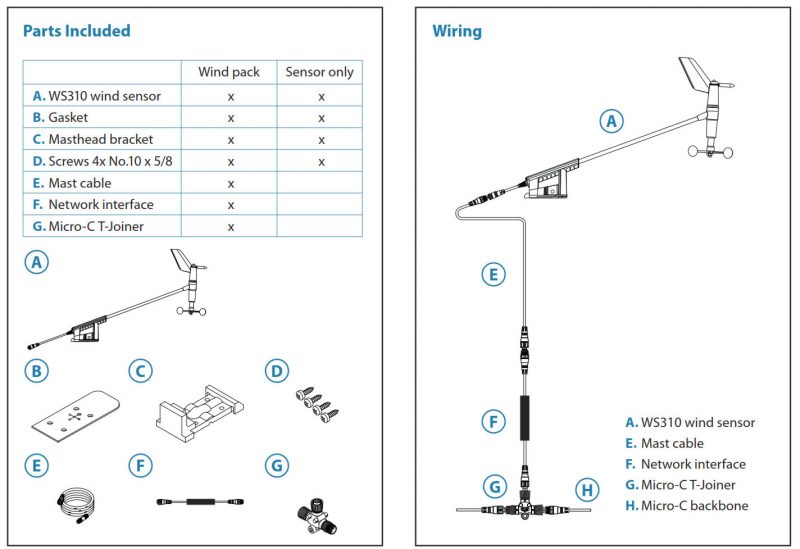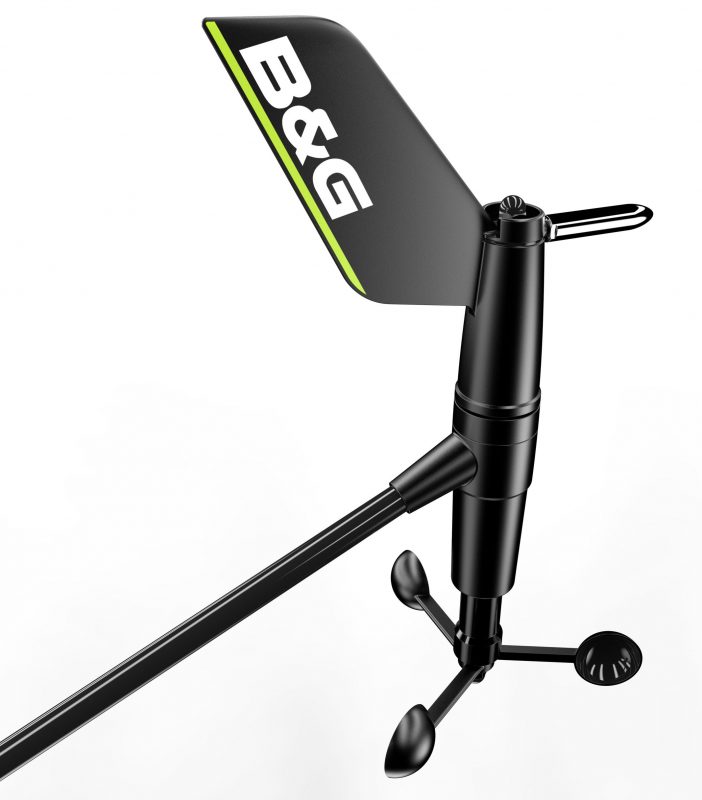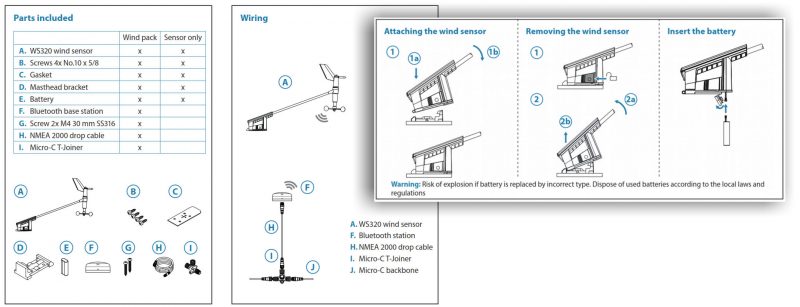New B&G WS300 wired & wireless NMEA 2000 wind sensors, no N2K mast cable needed
B&G just announced the WS300 range “of wireless and wired wind sensors designed for cruising and club racing sailors” and the first two models seem like smart designs at reasonable prices. I also appreciate the emphasis on reliability, as in:
“As the most exposed sensor on a yacht, the wind sensor is critical for instruments and autopilot steering. Reliability of these sensors is key and to address this the WS310 and WS320 have undergone rigorous validation. We have conducted benchmarking tests against multiple different sensors in over 500 individual wind tunnel tests and conducted over 200,000 hours of field tests without failure.”
The wireless WS320 model is said to work with masts up to about 25m (82 feet) and retails at $699 complete, while the wired WS310 Wind Pack is $599. What’s not obvious unless you dig into the manuals is how both can deliver NMEA 2000 wind information to a boat without having to run an N2K backbone up its mast. 
Note in these WS310 parts and wiring diagrams that the mast cable is not part of the boat’s NMEA 2000 network. Instead, there’s a short Network Interface cable that presumably converts an analog signal coming down the mast into N2K wind PGNs (messages) while also sending a little N2K 12v power up to the sensor. Why did B&G go to such trouble?
Over the years it’s become clear that a NMEA 2000 masthead sensor can be awkward to install and also a potential point of failure. That’s because standard N2K cabling is bulky to fish up a mast — with exceptions like BB Wire & Cable’s, and now defunct SimNet — and because it has to serve as part of the network’s backbone, with masthead termination included (unless your mast run is under 20 feet, the max for an N2K drop). Many boats with masthead N2K sensors have done fine, but they’re also a fairly common source of problems (like maybe this current one on the Forum).
NMEA 2000 network backbones can be fairly long — 100m (328 feet) for the typical micro size cables — but the bigger they get, the more care must be taken about voltage drops, dirty connectors, and so forth. And there’s no real point in sending all your precious data up to the masthead anyway, especially when a lighter, simpler cable can handle the sensor data and 12v power like the WS310 seems to. (And see the LCJ Capteurs CV7 ultrasonic wind sensor I’m testing for a similar networking architecture.)
While the B&G WS320 uses Bluetooth and solar power to eliminate the mast cable completely, the wireless base station again includes an interface into a boat’s NMEA 2000 network, and is also quite like Navico’s BT-1/WR10 Wireless Pilot Controller. I can’t think of another manufacturer who makes it so easy for an installer to optimally position a wireless gateway, but then again I also know boaters who bridle at the proliferation of little mushroom antennas.
Should the WS320 fail despite those 200,000 hours of problem-free field testing, it looks easy to remove without tools, as shown in the manual snip at upper right (and the same is true of the WS210, whose cabling is also easily detached when the mast is pulled). I’ll add that Garmin’s gWind Wireless 2 has a similar snap-on base and has tested well on Gizmo with a direct ANT connection to Garmin MFD’s, and that I’ll soon be telling you about the wonders of the Calypso Ultrasonic Portable.
















“…over 500 individual wind tunnel tests…” Did any of them involve fat-assed seagulls? In my experience, THAT is what kills wind sensors, not wind. This DOES look reasonable as a wind system, however – I don’t see any data on that cable: diameter, strength, etc. Given the hassles of pulling wire in the mast, wireless is looking more and more attractive
Valid points, Hartley. And did you encounter the Camden Harbor ospreys that seem to favor high whirlygig sensors? It seems like the birds would learn what poor perches they are, but some think the boatyard trains them.
I’ve gotten less skeptical about wireless now that I’ve seen longterm reliability with Garmin gWind, Raymarine Quantum radar, and FloatHub, but they use Ant and WiFi protocols, not Bluetooth. Also, to pair the B&G WS320, the manual recommends having it within 2m of the base station, and apparently it loses pairing if the sensor battery goes flat.
The 2m limitation on pairing is to stop the possibility of the WS320 base station pairing to another sensor at power on. This was a consideration for marinas or boat builders and commissioning. The pairing process is automatic and does not require a consumer to put the device into a pairing mode. Therefore, the power is reduced at startup when the base station is in pairing mode initially. In addition, it allows you to check all is working before climbing the mast an attaching the wind sensor, which was a consideration for boat builders and commissioning.
To reset the pairing, a consumer will need to remove the battery. This eliminated the need to design and build in external buttons for reliability or provide access to the PCB. And in the event of the N2k network being powered down, the wind sensor will go to sleep to conserve battery power.
A validation boat in Holland with a 27m mast, never saw the battery status go below 95% throughout the winter whilst maintaining a 5 Hz data output over Bluetooth. Charging to 100% during the day and dropping overnight.
The “validation boat in Holland” happens to be Merrimac, and I am very pleased with the performance of the WS320. It hasn’t lost a beat in over 6 months of testing.
The solar panel is so oversized that it seems completely fine even in winter when we have less than 6 hours of daylight.
I’m told this sensor is more precise compared to its wired predecessors in both wind speed and angle, and it certainly seems better behaved with more stable direction and believable wind speeds.
I looked at the description on B&G website and they didn’t give any spec for wind angle accuracy. Garmin claims better than +or- 1.5 degrees on the gWind. I am considering this as a replacement after a bird wiped out my Garmin wireless transducer. I made the dumb mistake of using 1/4″ Plexiglas for a mounting plate which snapped in half. Never could find the transducer. Is it OK to splice the wire? I don’t think the connector on the end would make it thru the conduit inside the mast. I plan to use an existing unused multi conductor wire to pull the new one thru with.
Why not use the wireless version, Al? I think that Bluetooth has a similar range to ANT, so if the gWind worked, the B&G WS320 should too.
But if you do want to cut and splice the mast cable for the WS310, I suspect it’s not a problem. I’d try to check with B&G first and I might well use solder seal connectors for what I presume are very small gauge wires. I’ve had several of these in use on my boat for more than a year now and they’ve stood up very well and they were quite easy to use. Solder is not usually used in boat wiring but these include a fair amount of heat shrink physical bonding and waterproofing. Example here:
https://www.amazon.com/Connectors-Sopoby-Waterproof-Automotive-Electrical/dp/B01LYXN6PO
Before I lost the Garmin transducer, I had nothing but trouble keeping the two paired. It did work fairly well after relocating the display but still occasionally dropped out for a few seconds. Garmin offered to swap it out for a wired unit after swapping out transducers and batteries. That’s why I am considering the wired version. I also question the reliability of bluetooth having issues with speakers and mice not staying paired with PCs. Yes I have used those solder splices and I agree that would be reliable way to splice. I have some on board.
The WS310 installation manual says “Data output: NMEA0183 MWV,R sentence at 10 Hz. ”
I do not see any explicit indication that the network interface is operating with NMEA 2K except for the fact that a Micro C connector is included.
So a couple questions.
– what is the signalling coming down the mast to the network interface (analog, NMEA 0183, etc)?
– if the vessel side of the network interface is NMEA 2K, which PGNs are supported, frequency, etc.
I have some concerns with accuracy if the unit is indeed doing multiple conversions between analog to NMEA 0183 to NMEA 2K.
Thanks
That’s mysterious, Sparky, and checking out the wireless WS320 just adds to the confusion with Data listed only as “Apparent wind speed and angle at 5 Hz.”
It’s my understanding that every certified NMEA 2000 device must include a list of the PGN’s it can read and output, but I don’t know if either the WS310 wired interface or the WS320 Bluetooth interface is actually certified.
On the other hand, Kees Verruijt (the WS320 tester in Holland who commented above) seems quite happy with the device and maybe he has figured out the PGN’s involved. I would think that the 310 and 320 are similar once they get to N2K, though the 10 and 5 Hz specs suggest otherwise.
Sparky,
I just tested the wired version in my lab, and it is definitely producing PGN 130306 Wind Data at 10 Hz.
There is a dongle like converter that converts the NMEA0183 (apparently, I haven’t physically tested this) coming down through the mast cable into NMEA2000. I think this is very smart as it means you don’t need to have a terminator 20-30m away. We’re now free to route the terminator anywhere we want.
I don’t see why there would be any performance issue, the conversion only adds a few ms delay. There is no precision issue.
For your benefit here is the boot log in CANboat format:
2019-01-03T16:37:45.656Z 6 2 255 60928 ISO Address Claim: Unique Number = 0xd3be; Manufacturer Code = B&G; Device Instance Lower = 0; Device Instance Upper = 0; Device Function = 130; Device Class = External Environment; System Instance = 0; Industry Group = Marine
2019-01-03T16:37:45.981Z 6 2 255 59904 ISO Request: PGN = 60928
2019-01-03T16:37:45.997Z 6 2 255 60928 ISO Address Claim: Unique Number = 0xd3be; Manufacturer Code = B&G; Device Instance Lower = 0; Device Instance Upper = 0; Device Function = 130; Device Class = External Environment; System Instance = 0; Industry Group = Marine
2019-01-03T16:37:46.045Z 2 2 255 130306 Wind Data: SID = 4; Wind Speed = 0.00 m/s; Wind Angle = 118.2 deg; Reference = Apparent
2019-01-03T16:37:46.141Z 2 2 255 130306 Wind Data: SID = 5; Wind Speed = 0.00 m/s; Wind Angle = 118.2 deg; Reference = Apparent
2019-01-03T16:37:46.237Z 2 2 255 130306 Wind Data: SID = 6; Wind Speed = 0.00 m/s; Wind Angle = 118.2 deg; Reference = Apparent
2019-01-03T16:37:46.333Z 2 2 255 130306 Wind Data: SID = 7; Wind Speed = 0.00 m/s; Wind Angle = 118.2 deg; Reference = Apparent
2019-01-03T16:37:46.445Z 2 2 255 130306 Wind Data: SID = 8; Wind Speed = 0.00 m/s; Wind Angle = 118.2 deg; Reference = Apparent
2019-01-03T16:37:46.498Z 3 2 255 130840 Simnet: Data User Group Configuration:
2019-01-03T16:37:46.498Z 3 2 255 130840 Simnet: Data User Group Configuration: Industry Code = Unknown
2019-01-03T16:37:46.498Z 3 2 255 130840 Simnet: Data User Group Configuration: Industry Code = Marine Industry
2019-01-03T16:37:46.546Z 2 2 255 130306 Wind Data: SID = 9; Wind Speed = 0.00 m/s; Wind Angle = 118.2 deg; Reference = Apparent
2019-01-03T16:37:46.642Z 2 2 255 130306 Wind Data: SID = 10; Wind Speed = 0.00 m/s; Wind Angle = 118.2 deg; Reference = Apparent
You’ll notice it is quite windless in my study
Oh, and it is OK to splice the wire, as long as you make sure it is properly waterproof & electrically sound.
Thanks a bunch Kees.
I’m looking to replace a 508. Very helpful. I agree … never liked the fact that the 508 required running the N2K bus up the mast. Also helpful to know that mast cable splice is an option. The 508 cable barely made it through my mast run, I expect the 310 connectors are larger. The 310 mount is also larger.
Beyond PGN 130306, did you encounter any issues with calibration/management PGNs, operation with Triton/Zeus, and the N2K/0183 translation occurring at the network interface?
have looked everywhere but cant find details for “how to calibrate” the WS310 unit.
I dont have any wind instruments (at present) & wish to interface WS310 to (existing) N2k network – and Axiom MFDs (for display of wind data )
Axiom MFDs “dont have calibration facility for wind instruments “ (per raymarine forum).
Q: how (if needed?) would I calibrate the WS310?
(wired version – including its packaged n2k interface)
eg : could it be calibrated (if required) via actisense NGT-1 (that i have on n2k network already)
Wind speed on these does not need calibration. This is done in the factory.
Wind angle can be calibrated using a Navico instrument display or MFD.
Where is the WS320 Wireless interface unit to be installed? Can it be installed on a bulkhead below deck?
Hi
does anyone know, if the WS320 (cable version) can be used as sensor for the Hydra 2000? I have a version from 2001 and since everything works fine, I don’t want to exchange this old hardware.
Is the wiring of the mast cable similar to the old MHU 213? And are the signals the same?
Any help is very welcome!
Dave
Sorry, I meant the WS 310, not the WS320.
Hi DMK,
This won’t work. The data coming down the mast cable is some digital protocol, most likely ( a variation of) NMEA0183. Not analogue like your MHU213. So either get a new MHU213, get a NMEA2000 to 0183 converter if your Hydra2000 has a free input for that.
To be honest, I think it is time to bite the bullet. Your Hydra displays are getting very long in the tooth and may well die soon, so it seems a waste to invest in old stuff.
Hi Kees
thanks a lot for the super fast reply! I just bought two old, but still good, FFD’s because indeed mine have issues.
The WS310 could be the start to exchange the Hydra. The MHU is just too expensive (1300USD).
My last resort: I have a Zeus Touch connected through NMEA0183 to the Hydra. Works super. If I could connect the WS320 through NMEA 2000 to the Zeus which then bridges the Wind data to NMEA 0183 which is then picked up by the Hydra so that I can display it on my mast head displays… Does that sound like a working concept?
Dave
Yeah that will work I guess. I don’t know whether the H2000 allows using nmea0183 as wind source, but the Zeus can definitely act as 2000->0183 converter.
Most of us looking to upgrade to H5000 or whatever already have a working (and expensive) MHU. So an alternative to replacing the MHUs with the new (inferior?) WS310 unit, I expect it should be possible to use that network interface to Micro-CT adaptor to get the wind sensor into the N2k network. Anyone tried that out yet?
No, nobody has tried that because the new MHUs are digital, not analog. The data signal to the converter is a digital datastream, rumour has it is a 38k4 NMEA-0183 signal.
Not to worry though — the H5000 cpu has a dedicated analog input for H2000/3000 style MHUs so no problem at all. It is only a problem if you upgrade to Triton 2 without a central CPU. Note that it is quite possible to upgrade to a H5000 CPU and use Triton 2 displays if you like them better. Only the H5000 autopilot requires a H5000 autopilot control display to set all niceties in there. You can tune and setup the H5000 CPU using a tablet or computer with a web browser.
Note that B&G is claiming that the new W300 and W700 units (=W300 on a longer stick) are better than their old ones.
Here is some more background info on the WS300 development: https://www.bandg.com/blog/ws300/
Thanks for the info Kees… I got this confirmed today also as I talked to a retailer about upgrading my installation to the H5000 pilot and Hercules processor. It is a real shame that all the installed H2000 FFDs (about 7 FFDs and 4 20/20s) will be useless after my planned upgrade to H5000. So, only the MHU and log will be possible to reuse from this 20 yo H2000 installation.
We have the WR10 Wireless Pilot Controller & BT-1 Bluetooth-to-N2K gateway installed, can I use the BT-1 gateway for the WS320 at the same time or do I need to install an extra BT gateway for the ws320?
You could check with B&G, Zoek, but the install manuals suggest to me that the BT-1 and WS320 Bluetooth base station may look the same but are neither interchangeable nor multifunction. So, yes, you’d need to install the WS320 base station to use the WS320 wireless wind sensor and it would work independently of your WR10 and BT-1:
https://www.bandg.com/downloads/#000-14388-001
https://www.bandg.com/downloads/#000-12316-001
Hello Ben, Thank you for your reply and explanation.
Best regards,
Zoek